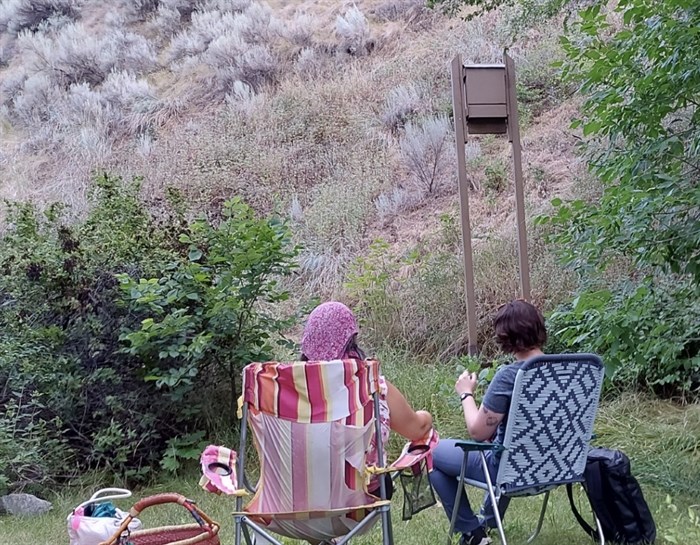
Volunteers counting bats from a bat box roost at Okanagan Lake Provincial Park.
Image Credit: Paula Rodriguez de la Vega
May 05, 2024 - 6:00 PM
The BC Annual Bat Count needs volunteers to help count up the little winged creatures this summer in North Okanagan.
Every year the BC Community Bat Program gathers volunteers to help with an important part of bat conservation, counting the population.
This year the bat counts start on June 1. Volunteers get together and enjoy late nights checking on the bats at maternity roosts around the province, according to a press release from the BC Community Bat Program.
“Female bats roost together in summer and raise their young in maternity colonies,” North Okanagan coordinator for the BC Community Bat Program Megan Olson said in the release. “Females generally only have one pup per year in June.”
Male bats don’t help with raising the babies and usually roost alone in trees, rock cliffs, boulder fields, barns and buildings.
READ MORE: There are more bats in the Okanagan than anywhere else in Canada
The Annual Bat Count is simply sitting outside a roost at sunset and counting the bats that come out.
“The maternity roosts that we count are in buildings, bat boxes, or bridges,” Olson said.
Volunteers conducted 888 bat counts at 274 different maternity roosts around the province last year.
“The data collected is really important as it helps us know how the bat populations are doing in BC,” Olson said. “We usually do four bat counts at every roost site – two in June to count just the females and two more starting mid-July when the pups are learning to fly.”
The first Annual Bat Count was in 2012 and is the only program that monitors bat summer roosts long term in BC.
The bat count helps detect problems with the ecosystem like diseases.
A bat population decline could be a sign of white-nose syndrome, a fungal disease that has killed millions of bats in eastern Canada and the U.S.
READ MORE: Biologists ask for your help to save Okanagan bats from deadly fungus
“A large number of the roost sites we count house little brown myotis and yuma myotis, both of which are susceptible to white-nose syndrome,” Olson said.
Click here to sign-up to be a citizen scientist and count some bats this summer, or report a bat roost.
To contact a reporter for this story, email Jesse Tomas or call 250-488-3065 or email the editor. You can also submit photos, videos or news tips to the newsroom and be entered to win a monthly prize draw.
We welcome your comments and opinions on our stories but play nice. We won't censor or delete comments unless they contain off-topic statements or links, unnecessary vulgarity, false facts, spam or obviously fake profiles. If you have any concerns about what you see in comments, email the editor in the link above. SUBSCRIBE to our awesome newsletter here.
News from © iNFOnews, 2024